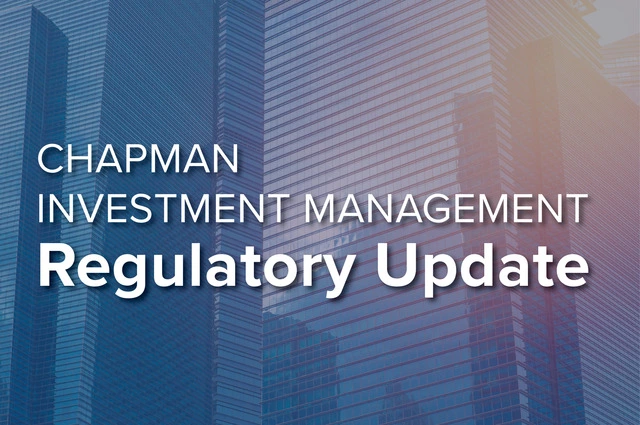- Topic: Asset-Backed Securities
26 matches.
On November 27, 2023, the US Securities Exchange Commission (“SEC”) adopted final Securities Act Rule 192 (“Final Rule 192”) prohibiting certain conflicts of interest in securitization transactions. In general, Final Rule 192 prohibits a “securitization participant” with respect to an “asset-backed security” (“ABS”) from directly or indirectly engaging in any “conflicted transaction” during the applicable prohibition period.
The International Comparative Legal Guide - Securitisation 2023, now in its sixteenth edition, is a leading legal text spanning the global securitization market, providing insights into the US and EU CLO market, cross-border trade receivables, taxation, and other topical issues and jurisdictions. Chapman partners David Nirenberg and Steven Kopp, recognized authorities on the tax treatment of US securitization transactions, co-authored the chapter entitled, "U.S. Withholding on Asset-Backed and Structured Securities."
On January 25, 2023, the U.S. Securities and Exchange Commission (“SEC”) issued a proposed rule to prevent and avoid material conflicts of interest in certain securitization transactions. The rule would prohibit securitization participants from engaging in certain transactions that could incentivize structuring an asset-backed securities (“ABS”) transaction in a way that would put the securitization participant’s interests ahead of the interests of the ABS investors.
- Journal of Taxation of Financial Products
The CARES Act, which was enacted to support individuals and businesses affected by the COVID-19 pandemic, provides that borrowers experiencing financial hardship due to the national emergency declared by the President, may request and obtain forbearance on certain federally backed mortgage loans.
On April 13, the IRS released Revenue Procedure 2020-26, which provides that forbearances and related modifications of certain mortgage loans will not be treated as replacing the unmodified loan with a newly issued loan for purposes of the REMIC and grantor trust qualification tests (and related REMIC-related taxes).
On April 9, 2020, the Federal Reserve released a revised term sheet for TALF 2020 that, among other things, broadens the range of assets that qualify as eligible collateral under the program.
On March 17, the Federal Reserve Board announced the establishment of two emergency funding facilities that closely mirror facilities established in 2008 during the last financial crisis in providing liquidity to both short and long term funding markets.
On July 16, in an open meeting of the FDIC Board of Directors a memorandum and resolution regarding a Notice of Proposed Rulemaking on a Proposed Amendment to Securitization Safe Harbor Rule was passed.
- Spring 2019Real Estate Finance Journal
Having failed in attempts to accelerate the termination of a CDO, an investor group holding senior notes filed an involuntary petition against an issuer to liquidate the CDO before its stated maturity under the U.S. Bankruptcy Code.
The state of Colorado initiated two lawsuits against online lending platforms. The suits alleged that the platforms had violated the state’s Uniform Consumer Credit Code by charging interest and some fees in excess of those allowed under Colorado law and that the consumer loan agreements utilized a non-Colorado governing law provision, also in violation of the law.
On June 14, the Board of Governors of the Federal Reserve System issued a final rule that establishes credit limits for single counterparties of US bank holding companies and foreign banking organizations with $250 billion or more in assets, and US intermediate holding companies of covered FBOs with $50 billion or more of consolidated assets.
On May 14, the Basel Committee on Banking Supervision issued two documents entitled “Criteria for Identifying Simple, Transparent and Comparable Short-Term Securitisations” and “Capital Treatment for Simple, Transparent and Comparable Short-Term Securitisations.”
- May 14, 2018
Today, the Basel Committee on Banking Supervision issued two documents entitled “Criteria for Identifying Simple, Transparent and Comparable Short-Term Securitisations” and “Capital Treatment for Simple, Transparent and Comparable Short-Term Securitisations.”
- March 2018
Chapman’s "Defaulted Securities: The Guide for Trustees and Bondholders" advances understanding and consideration of issues related to trustees and bondholders in both corporate and municipal financings.
- March 2018Journal of Taxation of Financial Products
This article describes the impact of the Tax Cuts and Jobs Act on securitization transactions. The article addresses in detail the new limitation on the deduction for business interest expense as well as the requirement that the transferee of an equity interest in a partnership engaged in a US trade or business withhold 10% of the amount realized unless the transferor certifies that it is a US person.
The US Court of Appeals for the District of Columbia Circuit recently issued a decision in a case that involved a question of whether the risk retention requirements imposed by Section 941 of the Dodd-Frank Act required open market CLO managers to retain risk in those transactions they managed.
On December 20, Congress passed the act commonly referred to as the Tax Cuts and Jobs Act of 2017. Although no provision of the Act was designed specifically to address securitization transactions, two new sets of rules are likely to have significant effects on at least some securitization transactions
On November 2, Representative Kevin Brady released the proposed text of the long-awaited federal income tax reform bill. The bill also includes a provision that creates a limit on the deductibility of interest. If enacted, this provision could have potentially wide-reaching impacts on securitization transactions.
- October 2017 (Originally Published July 27, 2017)Pratt's Journal of Bankruptcy Law
On July 6, 2017, the Basel Committee on Banking Supervision issued two consultative documents entitled “Criteria for Identifying Simple, Transparent and Comparable Short-Term Securitisations” and “Capital Treatment for Simple, Transparent and Comparable Short-Term Securitisations.”
- August 2017
Keeping track of the regulatory developments affecting asset-backed commercial paper (“ABCP”) conduits and their sponsors is a daunting task. This updated desk reference reviews regulatory and legislative developments affecting the ABCP market.
On June 12, the Department of Treasury issued the first report in a series regarding regulation of the financial system in a manner consistent with Core Principles set forth in Executive Order 13772 signed by President Trump on February 3, 2017.
- Client Alert
In this article, we provide a brief overview of the key reforms under Regulation AB II, followed by a more focused review of the next compliance hurdle that ABS issuers will face — annual compliance checks to determine continued shelf eligibility.
- Chapman Insights
The purpose of this article is to provide a general overview of how royalty-backed securitizations work and to encourage further use of royalty-backed securities by leaders in the music, business, and financial industries.
In August 2014, the SEC adopted final rules under Regulation AB that substantially revise the offering process, disclosure and reporting requirements for offerings of ABS. More than four years after the SEC originally published its comprehensive "Regulation AB II" rule proposals, and after two partial re-proposals in 2011 and 2014, the final rules implement several key areas of reform but defer action on other significant aspects of the original proposals.
- Chapman Clint Alert
By letter dated December 7, 2012, the Division of Swap Dealer and Intermediary Oversight of the Commodity Futures Trading Commission released interpretive guidance significantly expanding the scope of its October 11, 2012 interpretive letter. The October 11 Letter confirmed that securitization vehicles that satisfy five criteria, including a requirement that they operate consistent with either Regulation AB or Rule 3a-7 under the Investment Company Act of 1940, should not be “commodity pools” as a result of holding a swap nor should their operators be required to register as “commodity pool operators” under the Commodity Exchange Act and CFTC rules.
- Client Alert
By letter dated October 11, 2012, the Division of Swap Dealer and Intermediary Oversight of the Commodity Futures Trading Commission 1 released interpretive guidance confirming that certain securitization vehicles should not be included within the definition of “commodity pool” and that operators of such vehicles should not be included within the definition of “commodity pool operator” under the Commodity Exchange Act and CFTC rules. Separately, in a no-action letter dated October 11, 2012, the Division conditionally extended the deadline for registration as a commodity pool operator from October 12, 2012 to December 31, 2012 for vehicles that are commodity pools solely by virtue of their involvement with swaps.









